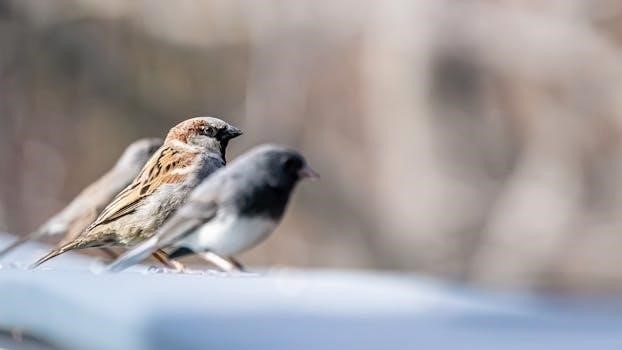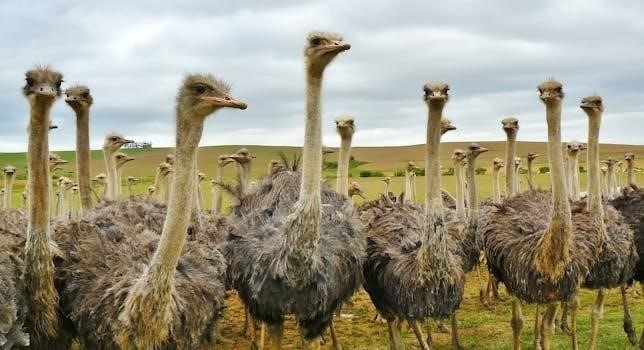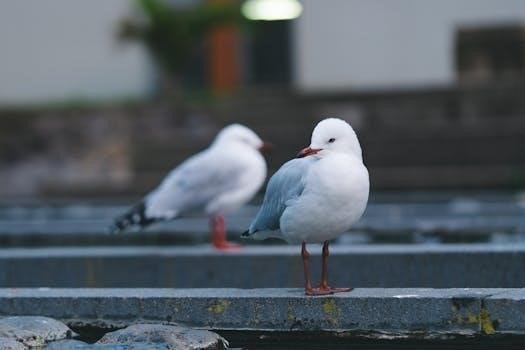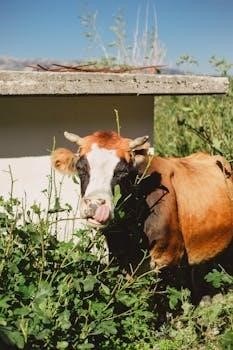New Jersey, with its diverse habitats, is home to over 480 bird species. Birding in NJ offers a chance to discover common backyard birds and rare wildlife. A field guide is essential for identification and learning about the birds.
Importance of Field Guides
Field guides are indispensable tools for bird enthusiasts in New Jersey, providing a wealth of information for accurate identification. These guides often include detailed descriptions, professional photographs, and range maps, allowing birders to distinguish between various species. They help navigate the diverse avian population, from common backyard birds to rarer species, ensuring a richer birding experience. A field guide is not just a book; it is a gateway to understanding the nuances of bird identification, making it easier to recognize birds by their distinct features. With such a tool, you can also learn about the habitat of the bird. They come in handy pocket-sized versions, perfect for on-the-go use or more extensive at-home versions.

Common Backyard Birds in New Jersey
New Jersey’s backyards are bustling with avian life. Common species include the Tufted Titmouse, American Goldfinch, Dark-eyed Junco, and Chickadee. These birds are often seen and heard in residential areas.
Tufted Titmouse
The Tufted Titmouse is a small, gray bird with a prominent crest on its head. It is a common sight in New Jersey backyards, often visiting feeders for seeds and nuts. This bird is known for its inquisitive and active nature. Its distinctive “peter-peter-peter” call is a familiar sound to many bird watchers. The Tufted Titmouse is a non-migratory bird, residing in New Jersey year-round. It’s a cavity nester, often using natural holes in trees or abandoned woodpecker holes. Identifying a Tufted Titmouse is usually straightforward due to its unique crest and coloring. Its presence adds charm to any garden or backyard birding experience in New Jersey, making it a favorite among bird enthusiasts.
American Goldfinch
The American Goldfinch is a vibrant, small finch known for its bright yellow plumage in the breeding season. During winter, its colors fade to a more muted olive-brown, but it remains a charming sight at feeders. This bird is often seen in flocks, flitting through gardens and meadows. They have a cheerful, melodic song and are known for their acrobatic feeding style. The American Goldfinch primarily feeds on seeds, especially thistle and sunflower. They are a common sight in New Jersey, both in urban and rural settings. Their presence adds a splash of color to any landscape. It’s a migratory bird, but some individuals may stay throughout the winter. The American Goldfinch is a favorite among bird watchers, for its beauty and lively behavior.
Dark-eyed Junco
The Dark-eyed Junco is a common winter visitor to New Jersey, often seen hopping around on the ground in search of food. This small sparrow is easily identified by its slate-gray head and back, contrasting with its white belly. Some populations may have brown tones, but the dark eyes are a distinctive feature. Juncos are often seen in flocks, especially during the colder months, and frequent areas near woodland edges and brushy fields. They are primarily ground feeders, scratching for seeds and insects. Their presence signals the changing of seasons, as they arrive in the fall and depart in the spring. Observing these birds provides a pleasant experience for bird enthusiasts. Their simple but elegant appearance makes them a welcome sight. They are a regular visitor to bird feeders.
Chickadee
The Chickadee, a tiny but energetic bird, is a common sight in New Jersey backyards. Known for its distinctive “chick-a-dee-dee-dee” call, this bird is easily recognized by its black cap and bib, white cheeks, and grayish back. Chickadees are incredibly active, flitting from branch to branch as they forage for insects and seeds. They are known to be acrobatic, often hanging upside down to reach food. During the winter, they are frequent visitors to bird feeders, showing a particular fondness for suet and sunflower seeds. Chickadees are year-round residents, adding charm to any garden. These birds are very curious. They are a pleasure to watch as they navigate their surroundings. The chickadee’s small size and lively nature make them endearing to observe. It is a popular bird among bird watchers.

Winter Birds of New Jersey
New Jersey’s winter season brings a variety of hardy birds. These include the Northern Cardinal, Mourning Dove, Downy Woodpecker, and Blue Jay. These birds remain active and are often seen at feeders.
Northern Cardinal
The Northern Cardinal is a striking sight in New Jersey, especially during the winter months. The male’s bright red plumage makes it easily recognizable, while the female displays a more subtle reddish-brown coloration; These birds are often seen at feeders and in backyard trees. Cardinals are known for their distinct, clear whistling songs and can be heard year-round. They are not migratory, remaining in New Jersey throughout the year, and are a common subject for bird watchers. They are frequently observed in suburban and wooded areas. Their presence adds vibrant color to the winter landscape. The Northern Cardinal is a beloved and easily identifiable species.
Mourning Dove
The Mourning Dove is another common year-round resident in New Jersey, often seen in backyards and open areas. They are recognized by their slender bodies, small heads, and soft, gray-brown plumage. These birds are named for their plaintive, mournful cooing calls. Mourning Doves frequently perch on wires and fences, and they are known to forage on the ground for seeds. They are relatively tame birds, often seen in suburban and rural environments. Their gentle nature and peaceful demeanor make them a familiar presence. They are a frequent visitor to bird feeders and are often observed in pairs. The Mourning Dove’s subtle beauty and calming presence make them a welcome sight. Their adaptability allows them to thrive across diverse landscapes.
Downy Woodpecker
The Downy Woodpecker is the smallest woodpecker found in New Jersey, a common sight in backyards and woodlands. It’s identified by its black and white plumage, with a small red patch on the back of the male’s head. These birds are often seen clinging to tree trunks and branches, searching for insects. They have a short, chisel-like bill perfect for tapping and probing. Their pecking can be heard throughout the forest and suburban areas. They are frequent visitors to suet feeders during the winter months. These small, active birds are known for their agility and persistence in their search for food; The Downy Woodpecker’s presence adds to the natural soundscape. Their ability to find insects helps control populations.
Blue Jay
The Blue Jay is a striking and intelligent bird common in New Jersey’s woodlands and backyards. Easily recognized by its vibrant blue, black, and white plumage, it also boasts a prominent crest on its head. These birds are known for their loud, often raucous calls, making their presence well-known in any environment. Blue Jays are omnivores, eating a variety of nuts, seeds, insects, and even small vertebrates. Their ability to mimic other bird calls is fascinating. They are also known for their role in dispersing acorns, helping to propagate oak trees. These adaptable birds are often seen in pairs or small family groups, adding color and character to the landscape. The Blue Jay is a charismatic and recognizable species.

Rare Wildlife in New Jersey
New Jersey is also home to rare wildlife species. A digital guide helps in identification, habitat knowledge, and conservation. This resource is vital for protecting these vulnerable birds.
Digital Guide to Rare Species
A digital guide to New Jersey’s rare wildlife is an invaluable tool for bird enthusiasts and conservationists alike. This resource offers detailed information on species identification, providing crucial insights into the unique characteristics of each rare bird. Moreover, the guide delves into the specific habitats these birds require, shedding light on the ecological factors that influence their survival. Understanding the status of these rare species, whether they are endangered, threatened, or of special concern, is paramount for effective conservation efforts. The digital format allows for easy access to information, including updated data and images. By utilizing this guide, individuals can contribute to the collective effort of protecting New Jersey’s vulnerable bird populations, ensuring their continued presence in the state’s diverse ecosystems. It serves as a bridge between scientific knowledge and public awareness. This digital resource supports conservation and research.

Bird Identification Techniques
Effective bird identification involves using field guides, and recognizing key features. Earth-tone clothing helps avoid scaring birds. Learning from other birders enhances skills for accurate identification.
Using Field Guides Effectively
Utilizing a field guide effectively is crucial for successful bird identification. Familiarize yourself with its layout, understanding how birds are categorized by family. Pay close attention to the illustrations and photographs, noting key markings, colors, and size comparisons. The guide’s range maps are essential for determining if a particular species is likely to be found in your location, and detailed species accounts provide valuable insights into habitat preferences. Before heading out, study the species you expect to encounter and note the distinctive features. Cross-reference what you observe in the field with multiple elements in the guide. Practice often and you will get better at navigating the field guide which is a great skill to have!
Importance of Earth-Tone Clothing
Wearing earth-tone clothing while birding is crucial for minimizing disturbance and maximizing your chances of observation. Birds are often sensitive to bright colors and may become startled or avoid areas where they are visible, therefore, blending in with the natural environment is important. Neutral shades of brown, green, and gray help you become less conspicuous, allowing you to approach birds more closely without causing alarm. This can result in better views and more opportunities to identify and study their behavior. Earth-tone clothing also ensures a more natural experience, allowing you to become a part of the landscape rather than a disruption. This simple practice can greatly enhance your birding success.
